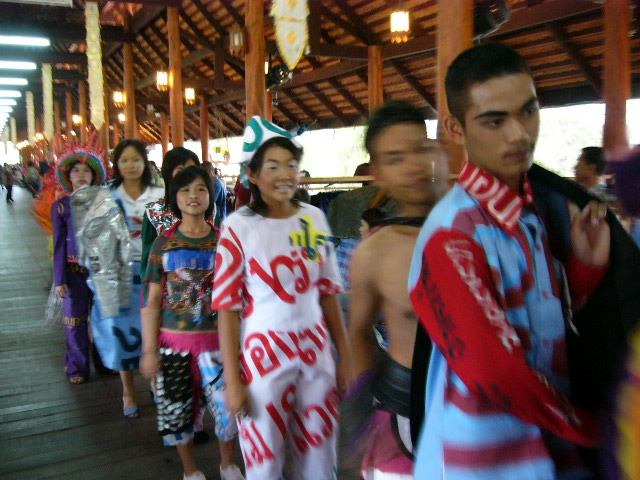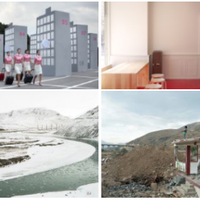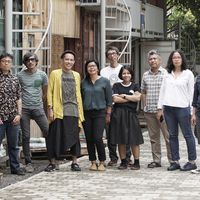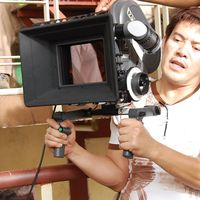Collaborations across borders | Two creative freelancers share their experiences
 In this article on creative freelancers, ASEF culture360 contributor Claire Rosslyn Wilson talks to artists Varsha Nair and Estelle Cohenny-Vallier about their experiences in collaborating across borders with artists and communities.
In this article on creative freelancers, ASEF culture360 contributor Claire Rosslyn Wilson talks to artists Varsha Nair and Estelle Cohenny-Vallier about their experiences in collaborating across borders with artists and communities. [caption id="attachment_53010" align="aligncenter" width="512"]
Olston, Estelle Cohenny-Vallier, Lampun secondary school students, Chiang Mai and Lamphun community.[/caption]
Both Varsha Nair and Estelle Cohenny-Vallier have rich experiences working across cultures. Varsha Nair studied fine arts in India and lived many years in the UK before settling in Bangkok, Thailand. Her practice includes performance, drawing, installation, video, writing, and organising projects. Drawn to Thailand for practical reasons, Nair soon found a supportive artistic community in late 1990s Bangkok. French artist Estelle Cohenny-Vallier uses simple techniques in her work, influenced by her background in textiles, and combines this with video and installation. Cohenny-Vallier was drawn to Thailand when she visited as a teenager, and after living for seven years in the UK, 16 years ago she moved to Chiang Mai, where she works with diverse communities. In this article they share what they have learned from their experiences in collaborating across cultures.
[gallery ids="53010,53020,53019,53018,53017,53016,53015,53014,53012,53011"]
Encourage open-ended discussions
For Nair, a project begins with an idea. In one project, Nair approached Thai architect Savinee Buranasilapin about a site specific installation on the topic of parking. Starting from a broad concept of turning a gallery space into a parking lot, Nair didn’t have any fixed vision for the final outcome. This open-ended exploration allowed both of them to respond to each other’s experience and expertise. It was a mutually educational process: Buranasilapin learnt how to work with an artist while Nair recognised that architectural drawings had more meticulous expectations.
When looking for collaborators, Nair explains that it often starts with a shared discussion where both artists find that they are on a similar trajectory in what they are thinking about. One collaboration with Bombay-based artist Tejal Shah came out of a discussion about how lonely it was to live in big cities. The conversation was primarily about cities where people were tightly packed in together yet were not really in touch with each other. These general discussions then developed into site specific performances. This organic process for developing project concepts is a common occurrence for Nair’s collaborations.
Agree on the expectations from the beginning
For Cohenny-Vallier, working on collaborative projects provides an opportunity to combine her interests in politics, community and art. When she first arrived in Thailand, she connected with community groups working with refugees from Myanmar. She worked at the intersection of art and community while teaching art and coordinating at Studio Xang, an organisation that provides free weekly art classes for migrant and exiled children from Myanmar.
Cohenny-Vallier’s first big collaborative project began in 2003, with the formation of an artist collective called Beauty Suit, which explored the concept of beauty in relation to social constructs, traditional beliefs and gender assumptions. As part of this collective, Cohenny-Vallier worked on Beautyform Unisuit with Thai artist Chakkrit Chimnok and Australian artist Katherine Olston. They were interested in how uniforms were perceived, and they interviewed school students and local communities to explore public opinion. The outcome was a performance installation, but they were also commissioned to design a new uniform based on the community participation. Cohenny-Vallier notes that there was a lot of process work, experimenting with different ways of doing things:
“Beauty Suit was based on collaboration…At the time there were some very interesting energies here [in Chiang Mai] of artists questioning classic Western models of who the artist is: What is the place of the artists in the local way of thinking? Is the artist cut off from the community or is it a member of the community? If you work with the community, who owns the work? And for Beauty Suit a very important thing was that each member of the community was equal, whether you’re an artist or not. And it’s not the artist who owns the work, but it’s done together, therefore it’s owned by every participant.”
This worked well for the collective as all the artists agreed from the beginning that the ownership would be shared, so everyone was very clear about what to expect. This meant that Beautyform Unisuit, a project by three artists and the interaction with the community, resulted in a whole body of work that was influenced and shared equally by all of them.
Use technology to create opportunities
Nair enjoys working with people from different geographic locations and she has often collaborated with European artists. One such project is Monday 2 Monday, a collaboration with Swiss artist Lena Eriksson, which saw both of them communicating every Monday since late 2011. Loosely based on the concept of communication, they talk about local and personal topics, based in the two different cities of Bangkok and Basel. From Monday to Monday, they built a network of connections about their environment as well as thoughts on their creative practice. It was constructed as a very open-ended project where the only fixed structure was the form of communication every Monday. Although the process was documented on a blog, this is only a fraction of the dialogue which took place. Nair confesses that initially she wasn’t sure how long it would last, but four years and an exhibition later, they are still inspired by the exchange. Nair observes that in a way, she communicates with Eriksson more often and more profoundly than many of her fellow artists in Bangkok, in spite of the distance.
“This virtual space became our studio to meet…If one Monday I have sent her something, there will be ten emails of on going discussion. So it became a conversation that probably we wouldn’t have had if we were living in the same city…We each could be in our home or studio and we could still be connected…If we were put in a residency together to do this it would have been forced in many ways, whereas this really grows organically.”
Another of Nair’s collaborations that explored the capacity of technology to overcome distance involved 600 Images from 60 Artists and 6 Curators presented over six cities of Bangkok, Berlin, London, Los Angeles, Manila and Saigon. Discussing the aim of the project, Nair explains that:
“The whole project was shared via email, the files were sent via file sharing sites and then they were printed out. It was a project to challenge the bringing together of an international show and how it could be done without the use of much resources in the sense of shipping or huge amounts of funding.”
Nair notes that is becoming easier to connect over distance, creating an online space that is very accessible and has the potential to be an online studio. Physical meetings are still important, but the virtual space creates new and potent opportunities that can be explored by individuals without needing extensive resources.
Be honest about your reasons for collaborating
Working in Chiang Mai, Cohenny-Vallier has observed that it’s important to be very clear about why you might want to collaborate with communities or local artists:
“Maybe [when you arrive] you’re not going to do art straight away – just be where your are, learn about the place. This is what is going to make a difference to you when you are networking with people. They’ll know whether you are doing that genuinely or if you’re just doing it to get something on your CV. You’re going to get a very different response…There are different reasons to come, to go to another place, but be aware of what your reasons are. You can think ‘I’m going to do this and I’m doing it for this reason’ but it’s not actually what you’re looking for deep down. But people will see through you a lot easier than you see yourself…So that’s why you’ve got to be honest with yourself, honest with other people. Know why you’re doing it, and if you’re not really doing it for the community then do it for you and that’s fine.”
Working in collaborations can be challenging, and this can be multiplied when working across cultures. Nair and Cohenny-Vallier develop meaningful connections by taking their time with their collaborative projects and they allow the ideas to grow organically from discussions with like-minded people.
Advice for creative freelancers
Varsha Nair:
- When working on collaborations you need to be open and willing to give up absolute control of the project.
- Invest in and commit to the collaboration. There will be challenges in setting it up, heated discussions or difficulty getting projects funded – understand that collaborations will be a challenge.
- With current technologies creating a virtual space as a meeting ground, collaborations across borders are becoming easier and more affordable.
Estelle Cohenny-Vallier:
- Be humble when working with communities.
- When working in a new country, take the time to learn about the place. It takes time. It helps if you learn the language, for example.
- To continue working as a creative freelancer you need to be stubborn and resilient. If you are overwhelmed by the difficulties, take some time out. There will be ups and downs, and it is important to work out ways to personally deal with the down times.
Claire Rosslyn Wilson is a poet and non-fiction writer who focuses on writing about arts and multicultural topics. She has eight years professional experience in resource development and the arts and has worked with international and non-profit organisations in Thailand, Singapore and Australia. She has had her work published in various journals and in 2014 she undertook fellowship at the Wheeler Centre to develop a book of poems. You can follow her exploits on Twitter @clairerosslyn





